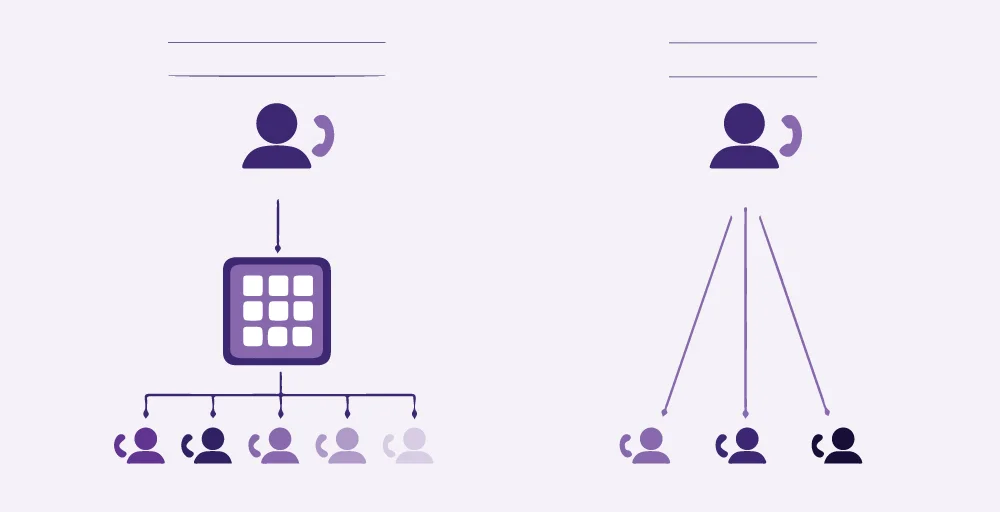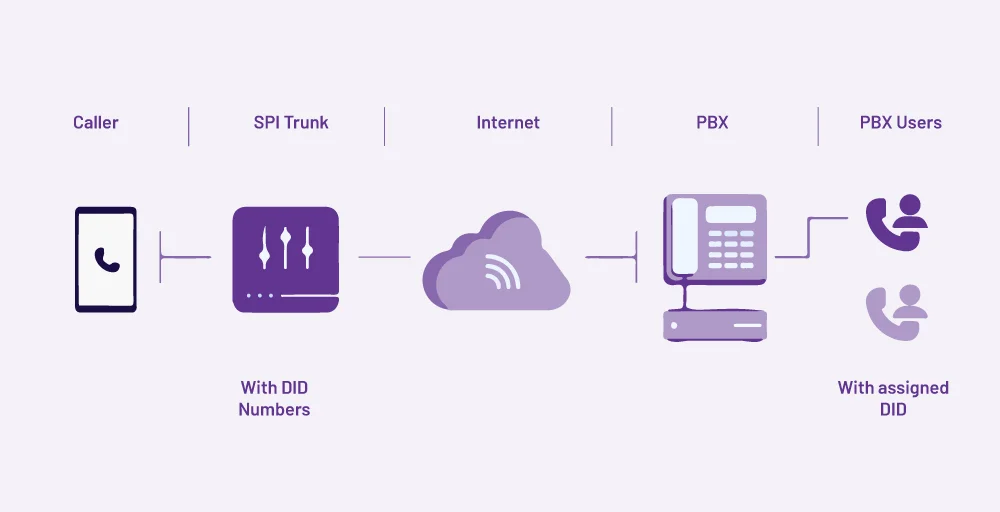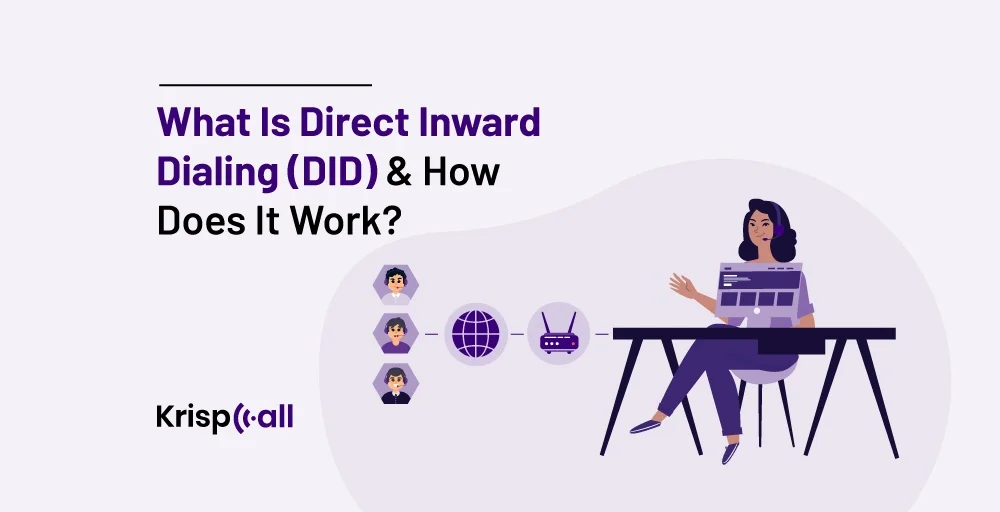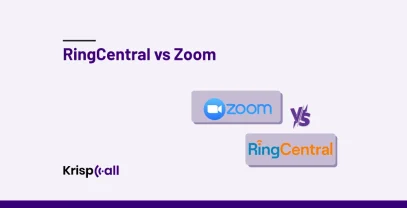When a customer calls your company with an urgent question and then gets stuck navigating a confusing 😮💨array of menus and hold times.
They might get frustrated 😤 leaving a negative experience with your business.
This scenario is all too common without Direct Inward Dialling(DID), a valuable telephony tech that facilitates better business telephony interactions.🤩
👉In this blog post, you will learn everything about DID numbers, including how they work, the different types available, their benefits and drawbacks, and how to obtain a DID number from the best providers.
Let’s get started right away!
🔑 KEY HIGHLIGHTS
- Direct Inward Dialing (DID) numbers enable you to directly connect with specific extensions on your own.
- Users can easily acquire DID numbers from VoIP service providers.
- Some types of DID numbers include individual, department, location-based, and virtual.
- Some of the best DID number providers are KrispCall, Nextiva, and RingCentral.
What is Direct Inward Dialing?

DID, also known as Direct Inward Dialling, is a phone system that allows customers to directly connect with a specific department or an operator without the hassle of going through automated menus or even a receptionist.
It’s frustrating for customers when they have to go through menus, even if they know which department or agent they are dialing. That’s why DID was invented – it saves customers and agents time by directly routing calls to the concerned department or operators.
To understand it better, let’s take an example: a customer inquiring about a certain product or service wanted to connect with the customer service department; instead of making customers travel through irritating menus, DID uses call forwarding and instantly routes the call to customer support.
What is a DID Number?
Direct Inward Dialling, or DID number, is just like your regular phone number. But here, DID is a virtual phone number that allows you to connect directly with a business phone system, surpassing automated or self-service menus. It is like a shortcut way to communicate with someone.
Customers can now avoid waiting for someone to pick up their calls with DID phone numbers, as calls are automatically redirected to the business phone system upon initiation. Moreover, DID phone numbers also provide customers with the ability to have personalized conversations with businesses, as companies can assign multiple phone numbers to different departments or team members.
How Direct Inward Dialing Works?

When someone initiates calls to a direct inward dial number, the service provider routes the call directly to the assigned user or phone. This call routing is handled by cloud-based VoIP or landline-wired PRI.
However, the DID transmission method depends entirely on your business’s phone system. Let’s explore each one to understand how DID actually works. 👇
Direct Inward Dialing with Cloud-Hosted VoIP
With cloud-hosted VoIP, your virtual phone number provider manages everything, including SIP trunking needed to receive incoming calls that can be via PSTN or VoIP. Then, your service provider virtually routes the calls to the designated DID number.
👉In terms of PSTN, using VoIP for DID offers several better benefits:
- Remote and global number assignment: You can purchase DID numbers from a cloud-based phone provider. Buy any number around the world and assign them to your remote workforce with ease.
- Better sound quality: The VoIP providers use advanced technology and codecs that offer HD voice and video quality.
- Scalability and flexibility: You can buy as many virtual DID numbers as you want, and if you want to discontinue the service, then you can do it from your comfort zone.
Direct Inward Dialing with Traditional PSTN
This is usually seen in traditional telephone systems, where companies are commonly seen establishing trunk lines attached to the PBX.
After that, the service provider assigns a bunch of phone numbers to these trunks, each aligned to a particular department or an operator within the organization.
Then, calls made to these numbers go through the physical phone lines and are diverted to the concerned recipient through the business’s private branch exchange(PBX).
Direct Inward Dialling with Fax
Direct inward dialing is not limited to phone calls. You can easily use it to route incoming faxes directly to specific users, contact numbers, or even computers. The VoIP phone system makes this possible, and you can easily set it up at any time. Sounds easy, isn’t it? But there’s a lot more on how it works.
A most used method is to assign a bunch of DID numbers to a computer that runs a fax server. Your company can assign multiple fax numbers to a single machine or multiple devices.
After that, you can assign a specific fax number to each employee’s email address within your business. Then, whenever a fax gets sent to an individual, it can be seamlessly transferred to the printer of their workspace or even their smart devices.
DID Vs DOD: What is the Difference?
Direct Inward Dialling allows callers to get connected directly to a specific department or operator within the business phone system.
Meanwhile, Direct Outward Dialling (DOD) allows employees to connect phone numbers outside of their PBX system without going through an operator or dialing the prior phone number(For example, pressing a specific button to initiate outbound calls etc.)
In addition, DID allows customers to easily connect with businesses, whereas the DOD facilitates smooth outbound call processes and improves operational efficiency.
Types of DID Numbers
There are different types of Direct Inward Dialling (DID) depending on how businesses want to manage their communication. Among the most common types are:
- Individual DID numbers: You can assign a unique phone number to each member that routes the incoming call directly to them. This makes it convenient for customers as they can directly call the desired department or operator without going through automated menus or a switchboard.
- Location-based DID numbers: You can assign a specific DID number to a dedicated location—for instance, a business location or a particular branch. So whenever a call is initiated to that particular number, it is diverted only to that specific address or location.
- Toll-free DID numbers: This one is commonly known as a toll-free number. A toll-free DID number allows customers or external users to connect with specific departments or agents without spending a penny.
- Department DID numbers: You may have seen multiple devices ringing simultaneously in a specific department or a group. That’s because a single DID phone number is shared between various devices, so a group of operators can easily handle a high volume of calls.
- Auto attendant DID numbers: This type of DID number is commonly associated with automated voice systems that offer different dialling options to reach a particular operator or department.
- Virtual DID numbers: These types of DID numbers are not associated with a traditional phone line; instead, they are hosted virtually. Then, calls are forwarded to any devices, including desk phones, softphones, computers, and mobile phones the company designates.
Benefits of Using DID Systems
Whether you’re a small or large business, DIDs cater to businesses of all sizes. With that being said, let’s have a look at some of its benefits:
- Immediate contact: With DID, callers can easily reach out to their preferred departments or operators. This eliminates the hassle of going through automated menus or virtual receptionist, facilitating a smooth telephony experience.
- Better call handling: The DID automatically manages and routes calls. Even if your line is busy, it transfers your calls to a queue or redirects them, contributing to effective call management.
- Cost savings: DID reduces the bulk investment required for infrastructure. Also, international call rates are cheaper with DID. In addition, DID eliminates the need for additional phone lines, resulting in further cost savings.
- Scalability: As your business grows, you can seamlessly add more numbers to your business phone system and quickly scale down DID numbers if needed. This allows you to maintain efficiency without significant infrastructure upgrades.
- Enhanced caller experience: DID numbers can reduce customers’ waiting times and unnecessary transfers. They allow customers to directly connect with the preferred department or agent, which significantly improves customer satisfaction and contributes to the overall customer experience.
- Increased Productivity: Routing calls to the concerned department saves customers time as well as increases agent productivity as they can deliver faster resolution to the customer’s inquiries. Moreover, calls can be routed directly to the operator’s mobile phone without revealing their private number, allowing them to connect with customers on the go.
- Accessible 24/7: The use of Direct Inward Dialling (DID) numbers allows businesses to operate 24/7, with the ability to direct calls to team members working remotely or globally, ensuring operations continue regardless of location.
Use Cases for DID
DIDs have many cases beyond basic business phone systems. Let’s have a look at some of the most used cases:
- Sales teams: The sales team can use specific DID numbers for lead generation purposes and measure the performance of each number. This can give them insights into which specific DID number is generating the most quality leads.
- Customer support: The DID numbers can help businesses separate customer support departments like product and service inquiries, technical support, and feedback. This allows customers to directly connect with their preferred department without going through frustrating menus. Also, this increases the efficiency of employees as they can quickly address the customer’s issues and promptly solve them.
- Marketing Teams: Businesses can assign a specific DID numbers to several marketing campaigns, and with that they can easily track the performance of specific campaigns based on the volume and origin of calls. These insights will provide them a clear understanding of which campaigns are more efficient and where to pour the rest of the marketing budget.
- Real estate management: Real estate businesses can assign DID numbers for several properties. They can divert the call of the potential clients to a specific agent of a specific property. This leads to better call response.
- Healthcare Industries: Healthcare sectors like hospitals and clinics can utilise DID numbers for several departments or services. For instance, they can provide separate DID numbers for appointments, specific clinics, or emergencies. This way, callers can easily reach their preferred department which in terms enhances the healthcare operations and services.
- Event Management: For event organisers, it can be hectic with loads of incoming calls. But with direct dial phone numbers, they can use it for specific services such as event information, ticketing, and emergency services. This will help them manage their call smoothly which in terms leads to better service for the participants.
Drawbacks of DID Phone Numbers
There might be some areas where DID may disappoint you. Let’s have a look at some of its drawbacks:
- Security concerns: DIDs can be risky to unauthorized access if effective security measures are not applied. You can protect DIDs with robust passwords, multi-factor authentication, and call masking.
- Number availability: Most of the time, a particular DID number or area code can be challenging to get as it’s in high demand by most users. You can choose a trustworthy provider who offers a wide range of DID numbers or some alternative area codes that, however, match your business needs.
- No call insights: Some DIDs lack in-depth call reporting features, which makes it difficult to analyze call data and optimize call handling. You can go with providers who offer seamless call tracking and integrate it with your CRM software for detailed data analysis.
- Technical issues: Sometimes, you may face dropping call quality and routing errors with your DID numbers. To eliminate this issue, you can choose a service provider who offers effective technical support 24/7.
How to Get DID Numbers?
When considering acquiring a Direct inward dialing number, you can easily obtain one through a cloud-based phone service provider. To make the process even simpler for you, here’s a step-by-step description of how to do so:
- The first step is to choose a VoIP provider, such as KrispCall, that offers DID numbers.
- You will now have to create an account on the website of the provider you have selected. As part of this process, you may have to provide information about your business as well as your contact information.
- Once you have an account, log in to the provider’s dashboard or portal in the next stage to select a DID number of your choice.
- Next, you can begin configuring your phone system to suit your needs.
- Finally, test your cloud-based phone system’s DID number by making a test call.
Conclusion
Direct Inward Dialling(DID) is undoubtedly a useful technology that allows you to connect with a specific team or department without the need for a middleman. DID numbers can help you improve your business’s telephony conversations and improve your customer’s calling experience. Also, as your business continues to grow, the DID numbers will play a more important role.
If you are considering getting a Direct Inward Dialling number or DID number, KrispCall is worth a try. With KrispCall, you can get virtual DID numbers from 100+ countries along with extensive features like shared phone numbers, call monitoring, call barging, call & contact tagging, and more.
FAQs
How much does a DID number cost?
The cost of a DID number can vary between several service providers. However, depending on the provider and specific features, it can range from $4 to $9.
What is direct inward dialing used for?
Direct Inward Dialing (DID) is a telecommunication feature that is used to route incoming calls directly to specific extensions within a company’s phone system without an operator.
What is the difference between DDI and DID?
DDI (Direct Dial Inward) and DID (Direct Inward Dialling) are essentially the same concept, with the main distinction being in the terminology used in different regions. DDI is commonly used in Europe, while DID is more prevalent in the US and other countries outside of Europe
How do I get a direct phone number?
You can get a Direct Inward Dialing phone number from a cloud telephony service provider like KrispCall.





